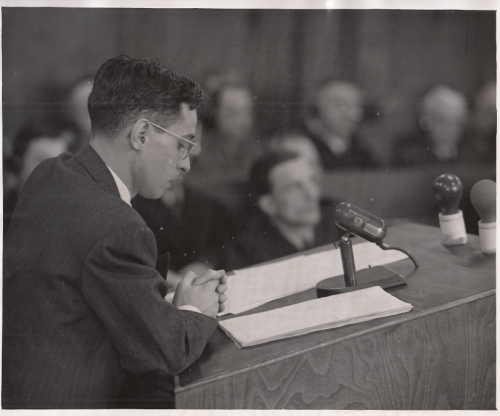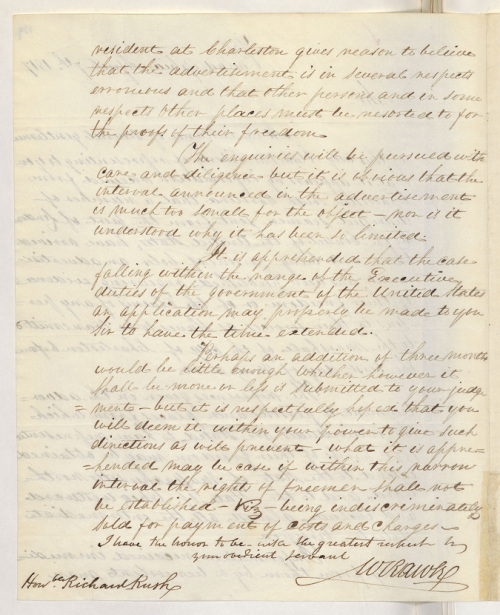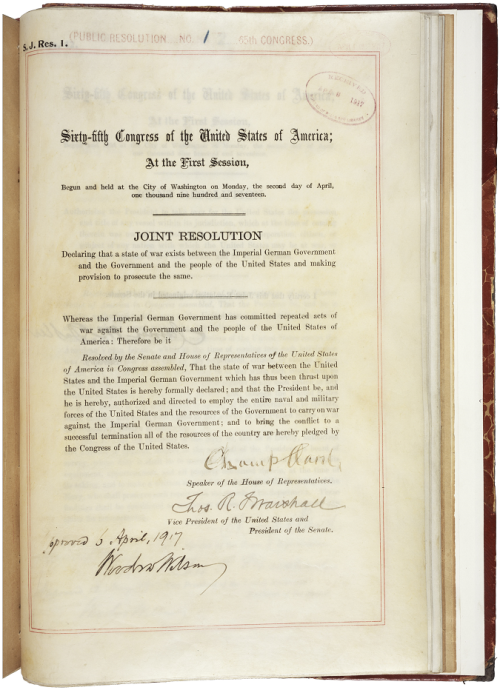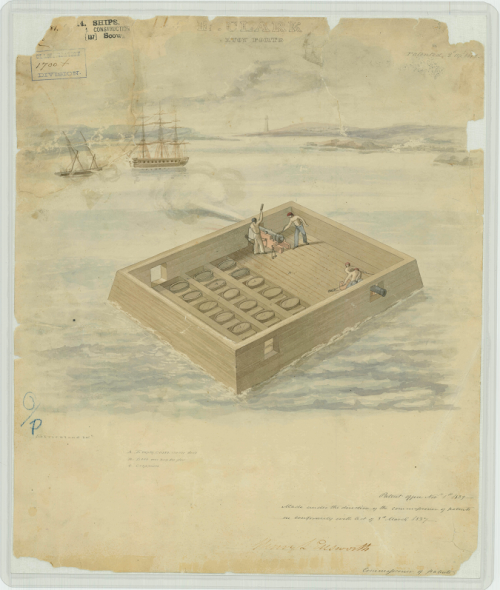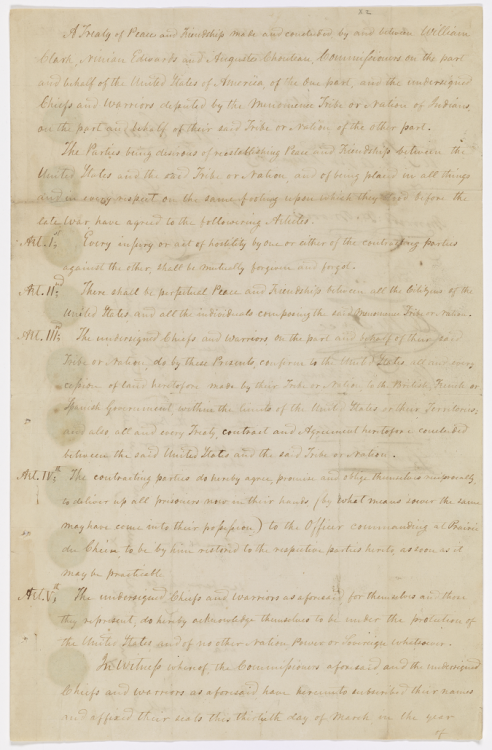#archivesgov
“An MP on motorcycle stands ready to answer all calls around his area. Columbus, Georgia,” 4/13/1942
Series: Photographs of American Military Activities, ca. 1918 - ca. 1981
Record Group 111: Records of the Office of the Chief Signal Officer, 1860 - 1985
Image description: A Black soldier sits on a motorcycle. He wears a service cap, holster, and tall boots with his uniform. A sign on the building behind him reads, “MILITARY POLICE / COLORED.”
Post link
War Department Pamphlet, Army Talk, Number 170 [cover and page 24], 4/12/1947
This pamphlet discusses the Army’s position on Black soldiers; answers from surveys about Black soldiers; and discussion of other minorities.
File Unit: Segregation in Armed Forces [1947-49], 1946 - 1953
Transcription:
WAR DEPARTMENT, WASHINGTON 25 D. C.
12 APRIL 1947
ARMY TALK
[handwritten note p29]
[illustration of Black troops performing mechanical work]
170
Note to Discussion Leader:
This ARMY TALK consists of three parts:
Part I - Negro Manpower in the Army
Part II - Negro Platoons in Composite Rifle Companies - World War II Style
Part III - What About Minorities?
This Talk is designed for discussion on three separate days as directed in section
V, WD Circular 76, 1947.
Before conducting the series, the discussion leader should read carefully section
V, WD Circular 76, 1947 and WD Circular 124, 1946, which are reprinted on the
last pages of this Talk. Circular 124, 1946, gives the general provisions of a revised
Army policy about the use, training, organization, and assignment of Negro personnel,
together with a reprint of the approved Gillem Board Report upon which
the revised policy is based.
In Part I of the Talk stress should be laid upon the threefold objective of the
policy:
1. An immediate objective - a more varied use of the Army’s Negro manpower
than has been peacetime practice hitherto.
2. An ultimate objective - the effective use of all available manpower, should
war come again, without regard to antecedent or race.
3. An over-all objective - increasing the effectiveness of the Army.
In all the Talks it should be borne in mind that the discussion of “race” is likely to
touch off sparks from individuals who have deep-seated beliefs, convictions, or
prejudices in one direction or another. Such discussions, however, may be handled
constructively if the group is kept aware that while differences in personal opinion
are to be expected and respected, the basic purpose of the Troop Information
Program is to bring information to troops and to develop understanding through
discussion.
These Talks, then, should inform troops about War Department policy and stimulate
discussion.
Part One
NEGRO MANPOWER IN THE ARMY
How to use its manpower best is always one of the Army’s problems.
How to use its Negro manpower best is in some respects a special
problem. It is of significance to the entire Army. To this special
problem several factors contribute:
(1) The “general run” of Negro soldiers have had considerably less
civilian schooling than the “general run” of white troops; they are
much less likely to have had civilian training and experience in highly
skilled mechanical fields; they make much lower scores on the Army
General Classification Test.
[sidebar] The most effective use of its
Negro personnel is of concern
to the Army.
WD Circular 124, 1946, and section V, WD Circular 76, 1947, appear on the last pages of this TALK
[page 2]
How did the Axis method work? It was simple. Get your victim to squabble with his friends instead of with his enemies. Play on his fears and resentments to make him hate groups of his own people. Start him quarreling at home. Break down his unity and strength. Thus you’ll weaken him so much that you can destroy him easily. It’s just an application of the old story of the bundle of twigs: when tied together they can’t be broken, but separately they are easy. United, they win; divided, they fall.
It’s no secret now that Hitler hoped to crack the United States wide open by driving wedges between the many groups on our population as he had done in some of the countries of Europe. It’s no secret that Japan tried to make the war in the Pacific a race war, with every person whose skin was “darker” united in a holy war against every person whose skin was white. That neither of these attempts got to first base in the United States or in our fighting forces means that in a time of national crisis the ideas that held us together as a nation were stronger than the differences that might have divided us.
Even at that, although , a public opinion poll made at the height of the war revealed that 85 percent of our population accused one or more of the following American groups of profiting selfishly from the war:
Farmers
Negroes
Jews
Foreigners
Protestants
Catholics
Business Men
Labor Leaders
Working People
That’s a pretty big list, isn’t it? How many Americans can you think of who don’t fall into one of those groups?
[sidebar] But the dangers of serious group antagonism are always with us.
And now that the fighting is over, now that we are trying to get back to peacetime status, and especially when the almost sure-to-come economic troubles begin to show up, the tendency to break up into groups, to point fingers, and to build up resentment against minorities can set in strongly without any pressure from the outside. We do not wish to use the Axis method on ourselves.
STOP How do scientists describe attitudes toward minorities?
[sidebar] A scientific view of group attitudes:
Not long ago a number of scientists at an American university, studying the matter of group attitudes, developed a chart they called “A Continuum of Relationships Among Human Groups." [superscript 1] For "Continuum” in this discussion we can substitute the word “scale.”
This scale or chart of how groups feel and act toward each other ranged all the way from persecution at the bottom of the scale to cooperation at the top. And on the way up it listed such attitudes and acts as discrimination, prejudice, preference, tolerance, and respect, in that order.
———————
[superscript 1] From The ABC’s of Scapegoating, published by the Central YMCA College, Chicago 6, Ill.
24
Post link
Men in Los Angeles’ Little Tokyo read bulletins with instructions on their impending removal to incarceration camps, 4/11/1942.
Series: Central Photographic File of the War Relocation Authority, 1942 - 1945
Record Group 210: Records of the War Relocation Authority, 1941 - 1989
Image description: Men stand on a sidewalk and read a sign posted in an empty shop window. The sign is in Japanese.
Post link
USAF SENIOR AIRMAN Katrina Edwards, assigned to the 60th Aerial Port Squadron at Travis Air Force Base, California, fills out an airway bill for a local carrier, 4/10/2002.
Series: Combined Military Service Digital Photographic Files, 1982 - 2007
Record Group 330: Records of the Office of the Secretary of Defense, 1921 - 2008
Image description: SRA Edwards sits at a desk and copies information from a box onto a form. She is wearing a woodland camouflage uniform, her hair is in a low bun, and she has a French manicure. On her desk is various equipment such as a telephone or fax machine, computer keyboard, and something that may be a printer.
Post link
“C Btry fired last American heavy artillery round in Vietnam,” 4/9/1972.
Series: Artillery Unit Records, ca. 1965 - ca. 1972
Record Group 472: Records of the U.S. Forces in Southeast Asia, 1950 - 1976
Transcription:
CONFIDENTIAL
DAILY STAFF JOURNAL OR DUTY OFFICER’S LOG
For use of this form, see AR 220-15; the proponent agency is
Office of Deputy Chief of Staff for Military Operations.
PAGE NO. 1
NO. OF PAGES 1
ORGANIZATION OR INSTALLATION
Hq 2d Bn 94th FA
LOCATION
AT989714
Hill 34, RVN
PERIOD COVERED
FROM HOUR 001 DATE 9 Apr 72
To HOUR 2400 DATE 9 Apr 72
ITEM NO. TIME INCIDENTS, MESSAGES, ORDERS, ETC. ACTION TAKEN INI-TIALS
IN OUT
1 0001 (U) Journal Opened.
2 1400 © C Btry fired last American heavy
artillery round in Vietnam. DSJ
3 SUMMARY: The last firing unit wi th a
tactical mission was released from it.
C Btry fired the last heavy artillery
round for American Artillery. C Btry
began standdown.
4 2400 (U) Journal Closed.
CONFIDENTIAL
DOWNGRADED AT 3 YEAR INTERVALS; DECLASSIFIED AFTER 12 YEARS, DOD DIR 5200.10
TYPED NAME AND GRADE OF OFFICER OR OFFICIAL ON DUTY
DERAL E. WILLIS, MAJ, S-3
SIGNATURE
[handwritten signature : Deral E Willis]
DA FORM 1594 1 NOV 62
PREVIOUS EDITION OF THIS FORM IS OBSOLETE
U.S. GOVERNMENT PRINTING OFFICE [illegible]
Post link
In Nuremberg, Mr. James M. McHaney opens Case Four against Oswald Pohl and others for war crimes and crimes against humanity, 4/8/1947
File Unit: Tribunal IV [4] – Pohl Trial – Prosecutors, 1946 - 1949
Series: Photographs Relating to the Minor Nuremberg Trials, 1946 - 1949
Record Group 238: National Archives Collection of World War II War Crimes Records, 1933 - 1949
Image description: Mr. McHaney stands at a tall podium with a microphone and reads from papers in front of him. In the background are the out-of-focus faces of others in the courtroom.
Post link
“ … a number of distressed seamen sent from the port of London by the Consul of the United States, have arrived [in Charleston] and being persons of Color an advertisement has been published requiring evidence of their freedom … “ 4/7/1817
File Unit: March THRU April 1817, 3/1/1817 - 4/30/1817
Series: Letters Received, 1789 - 1906
Record Group 59: General Records of the Department of State, 1763 - 2002
Transcription:
139
Philadelphia April 7th. 1817
Sir
At the instance of several gentlemen
of this City I take the liberty of representing to you
that it appears by information received from
Charleston South Carolina that a number of
distressed seamen sent from the port of London
by the Consul of the United States, have arrived
there and being persons of Color an advertise-
ment has been published requiring evidence
of their freedom or of the claims of any per-
sons to their services, as slaves to be transmitted
to the marshals of the city of Charleston before the first day of May next.
The references given in the adver-
tisement to persons and places from which
the individuals are stated to have represented
that proofs of their freedom maybe be obtained
extend to the State of Massachusetts north-
ward and to the State of Ohio westward
and include almost all the intermediate States to Virginia.
Information received immedi-
ately from them by a benevolent man
[page 2]
resident at Charleston gives reason to believe
that the advertisement is in several respects
erroneous and that other persons and in some
respects other places must be resorted to for
the proofs of their freedom.
The enquiries will be pursued with
care and diligence but it is obvious that the
interval announced in the advertisement
is much too small for the object – nor is it
understood why it has been so limited.
It is apprehended that the case
falling within the range of the Executive
duties of the government of the United States
an application may properly be made to you
Sir to have the time extended.
Perhaps an addition of three months
would be little enough whether however it
shall be more or less is submitted to your judge-
ments – but it is respectfully hoped that you
will deem it within your power to give such
directions as will prevent – what it is appre-
hended may be case if within this narrow
interval the rights of freemen shall not
be established – Viz – being indiscriminately
sold for payment of costs and changes.
I have the honor to be – with the greatest respect [unclear (“Sir”??)]
Your obedient servant
[signature (with extensions/flourishes at left & below):] W. Rawle
Hon[’]ble. [? (abbrev. for “Honorable”; letters in superscript after “b” unclear)] Richard Rush
Post link
“Resolved … That the state of war between the United States and the Imperial German Government which has thus been thrust upon the United States is hereby formally declared … “ 4/6/1917
Series: Enrolled Acts and Resolutions of Congress, 1789 - 2013
Record Group 11: General Records of the United States Government, 1778 - 2006
Transcription:
[stamp[ (except for handwritten “1”):]] (PUBLIC RESOLUTION NO. 1 65TH CONGRESS.)
S. J. Res. 1.
[ [oval] stamp [with date between upper & lower text]]
RECEIVED
APR 6 [?] 1917
BUREAU OF ROLLS AND LIBRARY [/stamp]
Sixty-fifth Congress of the United States of America;
At the First Session,
Begun and held at the City of Washington on Monday, the second day of April, one thousand nine hundred and seventeen.
[doubled (centered) separating horizontal line in Image]
JOINT RESOLUTION
Declaring that a state of war exists between the Imperial German Government and the Government and the people of the United States and making provision to prosecute the same.
[another (doubled & centered) horizontal separating line seen in Image]
Whereas the Imperial German Government has committed repeated acts of war against the Government and the people of the United States of America: Therefore be it
[words up to comma italicized in Image:] Resolved by the Senate and House of Representatives of the United States of America in Congress assembled, That the state of war between the United States and the Imperial German Government which has thus been thrust upon the United States is hereby formally declared; and that the President be, and he is hereby, authorized and directed to employ the entire naval and military forces of the United States and the resources of the Government to carry on war against the Imperial German Government; and to bring the conflict to a successful termination all of the resources of the country are hereby pledged by the Congress of the United States.
[signed] Champ Clark
[words italicized:]Speaker of the House of Representatives.
[signed] Thos. R. Marshall
[words italicized:]Vice President of the United States and
President of the Senate.
[handwritten] [A]pproved 6 April, 1917.
[signed] Woodrow Wilson
Post link
Wearing his WWI U.S. Navy uniform, a man of Japanese descent arrives at Santa Anita Assembly Center after being forced to leave his home on the West Coast, 4/5/1942.
Series: Central Photographic File of the War Relocation Authority, 1942 - 1945
Record Group 210: Records of the War Relocation Authority, 1941 - 1989
Image description: A gray-haired man in a WWI US Navy dress uniform holds the open door of a car. Another man wearing a trenchcoat and an armband reading STAFF writes on a notepad.
Post link
The first female F-16 Fighting Falcon Pilot, Second Lieutenant (2LT) Kristin L Bass, USAF, gets strapped into her F-16C Fighting Falcon by crew chief Technical Sergeant (TSGT) Kevin J. Jones, 4/4/2002
Series: Combined Military Service Digital Photographic Files, 1982 - 2007
Record Group 330: Records of the Office of the Secretary of Defense, 1921 - 2008
Image description: Second Lieutenant Bass sits in her fighter jet with the canopy open and her helmet perched on the side of the aircraft. Technical Sergeant Jones is leaning in to connect a buckle behind Bass’s shoulder.
Post link
Sketch of the Battle of Shiloh for General Beauregard, 4/3/1862.
From the War Department Collection of Confederate Records.
File Unit: Tennessee, 1861 - 1876
Series: Confederate Maps, 1861 - 1876
Record Group 109: War Department Collection of Confederate Records, 1825 - 1927
Image description: A map drawn in red, blue, and black, showing rivers, towns, roads, and railroads.
Image description: Zoomed in image of the map.
Post link
A rainbow for #AutismAwarenessDay! We’re glad to have our neurodivergent family, friends, coworkers, volunteers, and visitors in our lives.
Image description: A rainbow (and another, fainter, rainbow above the first one) in a cloud of water spray at the bottom of a waterfall at Yellowstone National Park.
Post link
E. Clark’s Patent Drawing for Buoy Forts, 4/2/1812
Series: Restored Patent Drawings, 1837 - 1847
Record Group 241: Records of the Patent and Trademark Office, 1836 - 1978
Image description: Colored drawing of a rectangular, walled vessel with square holes in the walls for cannon. Two men are firing a cannon toward ships in the distance.
Post link
As soldiers returned from overseas after WWII, the question arose: should Black soldiers be segregated when aboard Navy vessels?
The Navy reiterated “ … no differentiation shall be made because of race or color.” 4/1/1947
File Unit: Navy Department, 1946 - 1947
Series: General Correspondence with Government Departments and Agencies Files, 1946 - 1947
Record Group 220: Records of Temporary Committees, Commissions, and Boards, 1893 - 2008
Transcription:
Navy Dept
[very faint round stamp]
April 1, 1947.
MEMORANDUM
TO: Mr. Robert K. Carr
FROM: Milton Stewart
The following statement of Navy policy on racial minorities was made binding on the whole service in an order of the Secretary of the Navy (Allnav-No. 423) on December 12, 1945. It was transmitted to me by phone by Capt. Stickney, of Planning and Control, the Bureau of Naval Personnel:
Attention of the Navy Department has been called to a recent incident in which a question arose concerning accommodations aboard naval vessels for Negro Army personnel returning to this country for demobilization. In order to avoid any future misunderstanding on this subject the Navy’s policy regarding various racial minorities is re-stated and summarized for information and guidance.
In the administration of naval personnel no differentiation shall be made because of race or color. This applies also to authorized personnel of all the armed services of this country aboard navy ships or at navy stations and activities.
In their attitude and day-to-day conduct of affairs naval officers and enlisted men shall adhere rigidly and impartially to naval regulations, in which no distinction is made between individuals wearing the navy uniform or the uniform of any of the armed services of the United States because of race or color.
(signed) JAMES FORRESTAL
Secretary of Navy
Post link
We’re so excited about the 1950 Census!
The National Archives will release the digitized 1950 Census population schedules on April 1, 2022! These records have been kept confidential for 72 years, and researchers will be able to access them through a dedicated website on April 1 at 12:01 a.m.
Whether you are looking to build on your current genealogy research or you are just starting to explore your family history, the National Archives is ready to help you prepare for the census release on April 1. Visit archives.gov/1950census for blog posts, how-to videos, and other online resources.
Post link
Happy Trans Day of Visibility!
Photo: Transgender advocates at USCA 2016.
Series: Amy Lansky’s Twitter Posts, 2015 - 2016
Collection: Electronic Records of the Office of the President (Obama Administration) , 1/20/2009 - 1/20/2017
Image description: A group of people smile as they pose for a photo in a hotel conference room.
Post link
Barracks at a temporary “Assembly Center” as people await transfer to an incarceration camp on 3/31/1942. About 120,000 people of Japanese descent were removed from their homes during WWII.
Series: Central Photographic File of the War Relocation Authority, 1942 - 1945
Record Group 210: Records of the War Relocation Authority, 1941 - 1989
Image description: A man sits on a bed in a building with wooden plank walls. Shelves hold some personal belongings such as books, shaving equipment, and a photo. Two other beds, some folding camp stools, and a table are also visible. A piece of fabric is nailed up in front of the window.
Post link
Treaty Between the United States and the Menominee Indians Signed at St. Louis, 3/30/1817
“The Parties being desirous of reestablishing Peace and Friendship between the United States and the said Tribe or Nation …”
The Menominee had been allied with the British during the War of 1812.
File Unit: Ratified Indian Treaty 86: Menominee - St. Louis, March 30, 1817, 1789 - 1869
Series: Indian Treaties, 1789 - 1869
Record Group 11: General Records of the United States Government, 1778 - 2006
Transcription:
X2 [Written on the top]
A Treaty of Peace and Friendship made and concluded by and between William
Clark, Ninian Edwards, and Auguste Chouteau, Commissioners on the part
and behalf of the United States of America, of the one part, and the undersigned
Chiefs and Warriors deputed by the Menomenee Tribe or Nation of Indians,
on the part and behalf of their said Tribe or Nation of the other part.
The Parties being desirous of reestablishing Peace and Friendship between the
United States and the said Tribe or Nation, and of being placed in all things
and in every respect the same footing upon which they stood before the
late war have agreed to the following Articles.
Art. Ist; Every injury or act of hostility by one or either of the contracting parties
against the other, shall be mutually forgiven and forgot.
Art. IInd; There shall be perpetual Peace and Friendship between all the Citizens of the
United States and all the individuals composing the said Menonemee Tribe or Nation.
Art. IIIrd; The undersigned Chiefs and Warriors, on the part and behalf of their said
Tribe or Nation, do by these Presents, confirm to the United States all and every
cession of land heretofore made by their Tribe or Nation to the British, French or
Spanish Government, within the limits of the United States or their Territories;
and also all and every Treaty , contract and Agreement heretofore concluded
between the said United States and the said Tribe or Nation.
Art. IVth; The contracting parties do hereby agree, promise and oblige themselves reciprocally,
to deliver up all prisoners now in their hands (by what means soever the same
may have come into their possession) to the Officer Commanding at Prairie
du Chein to be by him restored to their respective parties hereto, as soon as it
may be practicable
Art. Vth; The undersigned Chiefs and Warriors as aforesaid for themselves and those
they represent; do hereby acknowledge themselves to be under the protection of
the United States and of no other Nation Power of Sovereign whatsoever.
In Witness whereof, the Commissioners aforesaid and undersigned
Chiefs and Warriors as aforesaid have hereunto subscribed their names
and affixed their seals this thirtieth day of March in the year
of
[page 2]
of our Lord one thousand eight hundred and seventeen and of the
Independence of the United States the Forty First.
Done at St. Louis in the presence of
[left column]
[signed] R. Wash, Secty to the }
Commissioners }
[signed] R. Graham
U.S. I. A. for Illinois Terty
[signed] T. Harrison
[signed] Nimrod H. Moore
[signed] S. Ganntt
Lieut. U.S. Army
[signed] CM Price
[signed] Richard T. McKenney
[signed] Amos Kibbe
[signed] Nathaniel Mills
[signed] Sam Solomon
[right column]
[signed] William Clark [seal]
[signed] Ninian Edwards [seal]
[signed] Aug. Chouteau [seal]
To-wa-na-pee
Roaring Thunder [his x mark] [seal]
Wee-Kay
The Calumet Eagle [his x mark] [seal]
Mue-quo-mo-ta
The Fat of the Bear [his x mark] [seal]
Wa-ca-quon or
Sho-min [his x mark] [seal]
War-ba-no
The Dawn [his x mark] [seal]
In-e–mi-kee
Thunderer [his x mark] [seal]
Le-bar-na-co
The Bear [his x mark] [seal]
Kar-Kun-de-go [his x mark] [seal]
Sha-Sha-ma-nee
The Elk [his x mark] [seal]
Pe-no-name
The Running Wolf [his x mark] [seal]
Post link
President George W. Bush Presents the Congressional Gold Medal to Dr. Roscoe Brown Jr., During Ceremonies Honoring the Tuskegee Airmen at the U.S. Capitol, 3/29/2007
Series: Photographs Related to the George W. Bush Administration, 1/20/2001 - 1/20/2009
Image description: President George W. Bush hands a display box with the Congressional Gold Medal in it to Dr. Brown. Several other Tuskegee Airmen look on, as does Laura Bush.
Post link
Japanese Americans incarcerated at the Portland Assembly Center published this newsletter, 6/5/1942. The Evacuazette documents life in the converted livestock exposition center.
File Unit: Unsolicited Testimony J, 1981 - 1982
Series: Unsolicited Testimony Files, 1981 - 1982
Record Group 220: Records of Temporary Committees, Commissions, and Boards, 1893 - 2008
Transcription:
Post link


![War Department Pamphlet, Army Talk, Number 170 [cover and page 24], 4/12/1947This pamphlet discusses War Department Pamphlet, Army Talk, Number 170 [cover and page 24], 4/12/1947This pamphlet discusses](https://64.media.tumblr.com/a008781338adc9cdedd215ae00881eea/d166b24b0c160c9c-de/s500x750/03bff5cbf3522f7b7a67eb2374cf488d2118955b.png)
![War Department Pamphlet, Army Talk, Number 170 [cover and page 24], 4/12/1947This pamphlet discusses War Department Pamphlet, Army Talk, Number 170 [cover and page 24], 4/12/1947This pamphlet discusses](https://64.media.tumblr.com/ed92bfa5cd526e6240e8f722bcccbc45/d166b24b0c160c9c-02/s500x750/b39d14f69dccfef37e414189a5041215c189292d.png)



